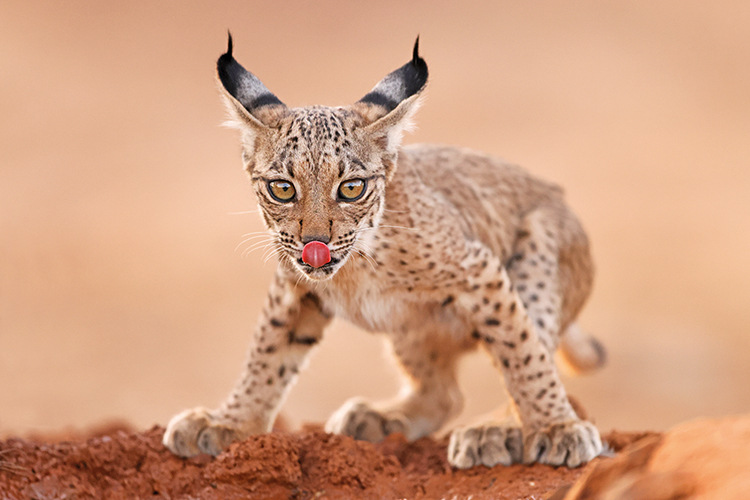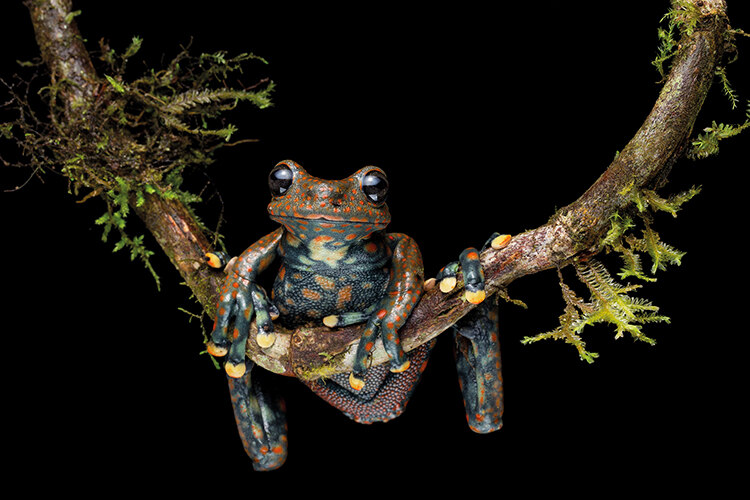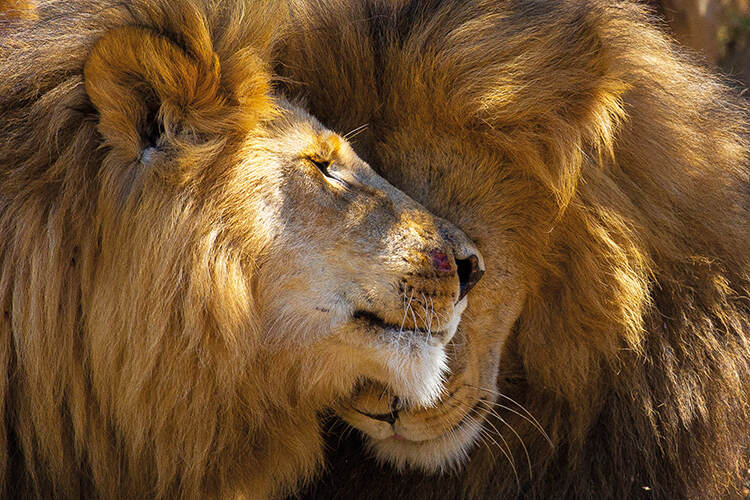
Bandhavgarh National Park, India
IUCN status: Endangered
‘Local people and officials in India are trying to protect the tigers in whatever way they can and the tiger population is now increasing on a large scale. This picture was taken on a rainy day. In Indian forests, it’s very difficult to get a proper picture of a running tiger as they are all thick forests. I kept the camera settings fast enough to freeze the running tige
The New Big 5 is a global photography project celebrating the animals we hold most dear
IUCN STATUS
CRITICALLY ENDANGERED, ENDANGERED, VULNERABLE
Spotting the so-called Big 5 remains a popular goal for those on safari in South Africa, Botswana or one of the other African countries blessed with extraordinary wildlife. But the term was first coined by travellers with a darker motive. The original Big 5 (the lion, leopard, rhinoceros, elephant and African buffalo) were the animals most difficult – and therefore most exciting – for colonial hunters to shoot and kill for trophies. This is also why we still refer to ‘game drives’. With this in mind, wildlife photographer Graeme Green started the project the ‘New Big 5’ to reclaim the gruesome term. To do so, he asked people around the world to vote on the five animals they most like to photograph and see in photos. More than 50,000 people voted. The New Big 5, a book that brings together 165 of the world’s greatest wildlife photographers and conservationists, celebrates the winners (elephants, polar bears, lions, gorillas and tigers), while also raising awareness about the issues that affect these creatures and many others like them.

Peñalajo, Ciudad Real, Spain
IUCN status: Endangered
‘Iberian lynx are one of the world’s most endangered cats, due to habitat loss, decreasing food sources, car accidents and illegal hunting. But thanks to conservation efforts, the species is recovering and can be found in small areas of Portugal and Spain. I captured this image while leading a conservation project based around photography in Peñalajo, Castilla La Mancha, Spain. I knew a family of lynx used this waterhole to drink, so I rigged up a hide close by. Focusing on this cub, I was lucky enough to capture the moment it lifted its head from the water, licked its lips and gazed straight into the camera.’

Lower Zambezi National Park, Zambia
IUCN status: Endangered
‘I spotted this beautiful constellation of tree trunks and immediately saw the potential for a great animal-scape. I decided to get into the perfect position and simply wait for an animal to walk into the natural frame. Luckily, the area has plenty of elephants, so eventually an elephant walked into my frame and I couldn’t have been happier. The elephants in this area have relatively small tusks and many of them have no tusks at all. This is the result of what is called “reverse evolution” – the survival of the weakest. Poachers are always targeting the biggest bulls with the largest tusks, so their genes are eliminated from the gene pool. The weakest bulls – the smaller ones, with small tusks or even no tusks at all – survive and get to procreate. I have been going to this area for more than 15 years now, and every year I see more tuskless elephants. I was lucky that this particular bull had sizeable tusks.’

Santa Barbara Park, Ecuador
IUCN status: Critically endangered
‘This is the spotted torrent frog, one of the most beautiful frogs on Earth. These frogs live on waterfalls in the Andean foothills. They measure around ten centimetres in length, and are characterised by their striking colours and patterns, including the tips of their fingers, where each species has its own colour of “nail polish”. Because of their very specific distribution, they are vulnerable to changes in their habitats, so it is essential to preserve their ecosystems.’

Naboisho Conservancy, Kenya
IUCN status: Vulnerable
‘Lions are one of my favourite animals to spend time with. Hearing them roar their territorial warnings across the grasslands of Kenya is unforgettable. Lions are powerful animals, global symbols for strength, courage and nobility. With this photo, I wanted to show their gentle, affectionate side and capture the behaviour between these two brothers, which roam Naboisho Conservancy together. African lion numbers have declined by around 50 per cent in the last 25 years. They currently occupy just eight per cent of their historical range. Bushmeat hunting (which reduces lions’ prey), habitat loss and human–wildlife conflict are all major factors. Lions are apex predators. Remove them and the balance between predator and prey is lost, which can have an impact on an entire ecosystem. The idea behind the New Big 5 project and book is to highlight the importance of all species – from bees to blue whales – to the balance of nature, healthy ecosystems and the future of life on Earth.’

Volcanoes National Park, Rwanda
IUCN status: Endangered
‘For photographing gorillas in the wild, Volcanoes National Park in Rwanda has no equal. It was in this area that Dian Fossey worked to help save the gorillas from extinction. Today, their numbers are steadily increasing. The proximity I could get to the gorillas came as a surprise. This up-close-and-personal experience is truly one of the greatest moments one can experience in the wild.’

Gombe Stream National Park, Tanzania
IUCN status: Endangered
‘In 2018, I was fortunate to make my first visit with my dear friend Jane Goodall to Gombe Stream National Park, the nature reserve in Tanzania where her monumental chimpanzee research began in the late 1960s. For days, Jane and I wandered along animal trails in the mountainous jungle of Gombe, rising at first light and staying out until dark, hoping to get a glimpse of the chimp families moving between high and low ground. On the last day, as if on cue, magic happened when a family group of a dozen chimps came down from the trees into a clearing. This photograph is of a ten-month-old chimp named Gombe, grandson of Gremlin, a chimp that Jane studied and knew well. Gombe was leaning against his mother, Glitter. Millions of chimps used to live throughout equatorial Africa. However, the bush meat trade, destruction of habitat and the black market for live chimps and animal parts have had devastating effects. Currently, chimps are classified as endangered, with between 170,000 and 300,000 thought to still exist in the wild.’

Palm Beach, Florida, USA
IUCN status: Vulnerable
‘Atlantic goliath groupers are massive fish that can live for dozens of years, growing up to 2.5 metres long and weighing up to 360 kilograms. The groupers aggregate in large numbers along the Atlantic coast of Florida every year at the same locations to reproduce. Decades ago, following a severe decline in the population of the fish, Florida banned their capture, leading to an increase in the population. Now, there are new plans to reopen fishing, which may put their future in danger once again. Trying to find an interesting composition for this large, easygoing fish, I got lucky on one dive – vast schools of big eye scads had surrounded the groupers, which ignored the silvery school in favour of larger prey. I observed, captivated, as the groupers swam calmly through the swirling school. I used a slow shutter speed to give a sense of motion and waited for a goliath to emerge from the school.’

Wapusk National Park, Manitoba, Canada
IUCN status: Vulnerable
‘I saw this polar bear family pause during its trek to the sea ice to hunt seals on a frozen day in the Arctic. At this moment, these adorable twin cubs turned their first adventure into playtime by using their patient mum as a playground. They were only around three months old and had just emerged from their maternity den a few days earlier. Since the polar bear cubs are young and helpless in the harsh Arctic, they rely on their mother for everything they need to survive, until the cubs are about two-and-a-half years old. The weather was –40°C, accompanied by intense Arctic wind. But it was a privilege to get this image in a restricted Arctic denning area in Wapusk National Park, Canada, which I’d gained permission to enter.’

Foping National Nature Reserve, China
IUCN status: Endangered
‘In the Qinling Mountains in Shaanxi province, golden monkeys live in low-altitude areas, around 2,000 metres, in winter and early spring. Their living environment is away from people, so it is difficult to photograph them. It was the coldest day in January when I took this photo. Under the leadership of the forest rangers in the nature reserve, we found a golden monkey family. Some of them were resting and some were playing back and forth among the branches, not affected by the weather at all. Their golden hair stands out against the snow. They have prominent mouths and nostrils facing the sky, and their whole body is covered with fine and soft golden hair.





